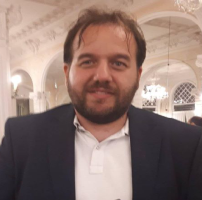Day 1 :
- Oral Presentation
Session Introduction
Marco Milone
Film Producer, Administrative Director, The Nemesis, Italy
Title: The Italian neo-pictorial movement

Biography:
Marco Milone as Film Producer (Revengeance, The Mafia Is Not What It Used To Be), Special Jury Prize at Venice Film Festival and movie critic. He was jury member for the Future Film Festival - section shorts- and for the Pisa Robot Film Festival. As Japanologist, he also lectured at universities and in many festivals about Japanese board games, ukiyo-e, emaki and shinto, and wrote articles and books. He's also a shareholder of many startups, and actually he's board member of Freedom Waves and Undo Studios as well as Administrative Director of The Nemesis (https://thenemesis.io/), a gaming, entertainment and social platform, launching an anticipation of how the web will evolve in the coming years. Among his honors, he has been awarded with an honorary mention as comics journalist at Franco Fossati Award for his book “Fumetti”, has played twice as Italian representative in the shogi tournament “Yingde Cup” (2009, 2010) and has received an honorary degree in Naturopathy.
Abstract:
Marco Milone will introduce us to the most important section of Italian independent animated movies, investigating how a movement can born without a real source or date. In fact, what is strange about Italian neopictorial animators is that thet seem to have started working on different projects in fully autonomy, without sharing or confront themselves about style or themes.
In a world dominated by the need to show themself, there are still artist which seeks out to create artistich projects, and that most of all they decided to go back to the original source of painting, rejecting computer graphic, and evocating the origins of animated movies which has started through the abstract animation of Ginna e Corra.
If we can indentify a leitmotif in artist who hasn't worked together, the surprising thing arise from the understanding that this group of artist are the only one Italian that are giving a real contribute to the state of innovation in the world's cinema animation. This common theme in their works has already gathered pubblic attention since the 2006 edition of Annecy Festival when the term neopictorial movement was used to introduce collectively artists alike Gianluigi Toccafondo, Ursula Ferrara, Roberto Catani, Simone Massi and Andrea Pierri.
Kevin Taylor
Assistant Professor, California State University, Chico, USA
Title: Modular 3D environmental development for augmented reality

Biography:
Kevin Taylor is an Assistant Professor in the Computer Animation and Game Development Program in California State University, Chico, USA. He is a veteran video games artist who has created work for publishers such as Bethesda Softworks, SEGA, Activision, Konami and Ubisoft. He teaches upper division courses such as (CAGD 445) Animation/CGI production, and lower division courses such as Digital Modeling and Concept Art and Storyboarding. He is a passionate educator and has taught in Europe, Australia and around America. His research interests include Augmented Reality, 2D/3D animation and comic book development.
Abstract:
This work used industry standard practices and technologies as a foundation to explore the current and future advancements in 3D environmental production. Outlining how the field is moving towards the inclusion of AI assisted generation, and its role in immersive Augmented Reality environments. This study will explore modular environmental construction techniques utilized in large scale 3D productions. This will include the reasoning behind this approach to production, the principles in successful development, potential pitfalls and different methodologies for successful implementation of practice in commercial and proprietary interactive engines. A focus will be on the role of the 3D environmental artists in maximizing their productivity in this field, preparedness for changes in this area, and preparation for new challenges faced by evolutions in this field, driven by tandem technological advancements. With a basis established, the study will utilize data to analyze progression in the field of modular environmental construction, identifying progression available through Artificial Intelligence. This will include implementation within current industry standard software’s, as well as within the field of interactive Augmented Reality environments, to achieve the industry goal of fully immersive A.R. environments, and how this will impact technological engagement.
Isham Alzoub
University of Tehran, Iran
Title: Prediction of environmental indicators in land leveling using artificial intelligence techniques

Biography:
Isham Alzoubi has completed his PhD at the age of 27 years from Doctor of Philosophy degree in Agricultural Mechanization Engineering (University of Tehran – Iran) University and Postdoctoral Studies from School of Surveying Geospatial Engineering-Department of Surveying and Geomatics Engineering, University of Tehran. Currently working as a General commission for scientific Agricultural Research – Damascus – Syria (Mechanical Engineer). He has published more than 16 papers in reputed journals and has been serving as an editorial board member of repute.
Abstract:
Land leveling is one of the most important steps in soil preparation for agricultural and other purposes. . New techniques based on artificial intelligence, such as Artificial Neural Network, integrating Artificial Neural Network and Imperialist Competitive Algorithm (ICA-ANN), or Genetic Algorithms (GA-ANN), or Particle Swarm Optimization (PSO-ANN) have been employed for developing predictive models to estimate the energy related parameters and the results were compared to SPSS and Sensitivity Analysis results. In this study, several soil properties such as cut/fill volume, compressibility factor, specific gravity, moisture content, slope of the area, sand percent, and swelling index were measured and their effects on energy consumption were investigated. Totally 90 samples were collected from 3 land areas by grid size of 20m×20m. The aim of this work was to develop predictive models based on artificial intelligence techniques to predict the environmental indicators of land leveling . Results of sensitivity analysis illustrated that only three parameters consist of soil density, soil compressibility, and soil cut/fill volume had meaningful effects on energy consumption. Among the proposed methods, the GA-ANN had the most capability in prediction of the environmental energy parameters. However, for prediction of LE and FE the ANN and ICA-ANN algorithms had better performance. On the other hand, SPSS software had higher R2 value than Minitab software and sensitivity analysis and in fact close to the ANN values.
.Originality/value – A limited number of research studies related to energy consumption in land leveling have been done on energy as a function of volume of excavation and embankment. However, in this research, energy and cost of land leveling are shown to be functions of all the properties of the land, including the slope, coefficient of swelling, density of the soil, soil moisture and special weight dirt.
Tariq Alrimawi
Jordanian Animated Film Director, University of Petra, Jordan
Title: The capability of media students to interact with three-dimensional augmented reality in virtual broadcast news studios

Biography:
Tariq Rimawi is a Jordanian Animated Film Director and Scriptwriter. In 2010, he graduated with a Master’s Degree in Animation from Newport Film School in the United Kingdom. He wrote and directed three short animated films ‘Missing’ in 2010, ‘Growing’ in 2013, and ‘Surprise’ in 2016. His shorts have been screened at more than 170 international film festivals and received 15 awards domestically and internationally. In 2014, he completed his PhD studies from The Animation Academy at Loughborough University in the United Kingdom. In 2016, he established the Animation & Multimedia Department at the University of Petra in Jordan. To see more of his projects: www.tariqrimawi.com.
Abstract:
The latest developments in technology are constantly affecting all fields, including through the implementation of augmented reality (AR) in media broadcasting. Using AR would improve the public image of broadcasting and allow international, national, and regional information and stories to be presented impressively and effectively, allow presenters to interact with television stories through a three-dimensional virtual world, and provide the viewer with rich information about the world. However, the undergraduate media departments at universities in Jordan are still teaching the presentation of the news in basic newsrooms. Therefore, this paper presents an experimental collaboration between the Television Department and the Animation/Multimedia Department at the University of Petra involving the use of an AR virtual studio and three-dimensional computer graphics animation to teach performance skills to students who aim to become television news anchors after graduation. This experimental research will give the students a new approach and tool for storytelling, including techniques to deal with technological evolution in the media field. This paper evaluates the impact of employing virtual worlds in newscasts as an effective method of education delivery for Jordanian students.
